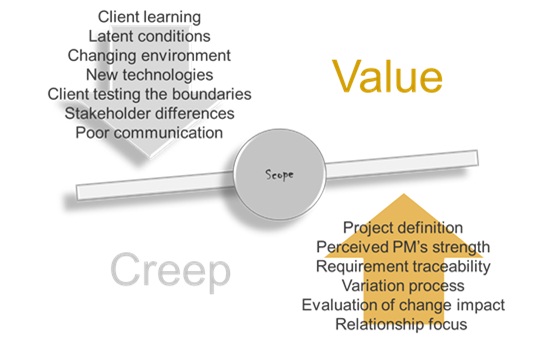Scope Creep: Balancing Risk and Value
Continuing on the topic of project creeps – see previous post “When Problems Creep Into Your Projects – this post is about the most common and well known of the creeps – scope creep. By scope creep we usually mean an unplanned change to project scope that is not accompanied by an appropriate change of the planed deadlines and budget of the project. As all creeps, it is dangerous, as it expands project commitment, increases its risk exposure, misallocates scarce resources and may jeopardise the project as a whole.

Most often project scope creep is driven by the project customer. Everyone who has ever played this role would know how it feels. We define a project thinking we know what we need and proceed to commence the works. But as the project progresses, we find new brilliant ideas that improve project value and even if we know that these were not included in the original scope, we will see if we can sneak some of them in without additional cost. In the case of home renovations, we add new floors, more ceiling lights, more kitchen cabinets, a spa bath… and lots of other things that are not in the original plan, each item adding costs and delaying the project.
Another major reason for additional scope may stem from unknown or changing project environment, like a discovery of live wires in the bathroom wall left by a previous contractor or the need for additional coats of paint. We also learn about new technologies and materials and wanted to use them in our project.
These issues may be a source of fun in home renovations, but they may have a major impact on large and complex projects. Project exposure is exacerbated by vague or incomplete project definition that allows misinterpretation. Poor communication between the parties and differences between the requirements of different stakeholder groups lead to time consuming disputes. All these create weaknesses in the project for the unplanned and uncontrolled changes to creep through. The only barriers in the creep’s way are the Project Manager and robust project management processes.
Preventing and Managing Scope Creep
The first line of defence is project definition. SMART definition of project deliverables that is written in clear unambiguous language and properly signed-off helps the team to draw a boundary around their work commitment and effectively convert creep attempts to project variations. As soon as a variation is negotiated, it stops being a creep and becomes and new project baseline. Let me know if you want to discuss good practices in project definition and variation processes.
Project Manager’s ability to say “No” to scope creep is the key to successful deflection of creep attempts or their conversion to variation. A project manager who is perceived to be weak or inexperienced is likely to face more clients’ attempts to stretch the project than someone who is clearly determined to protect their project from creeps. Experienced PMs defend their ground by referring to project definition and assertively explaining the consequences of proposed change. They know when and how to say “No”.
But having said that they also know when to say “Yes”.
The Strategic Value of Scope Creep
We all know that sometimes it may be in the best interest of the project to give a small concession to the client. Too many assertive rejections create a bitter aftertaste that may jeopardise long term business opportunities. Strong client relationship, built on mutual understanding and good will, on the other hand, can help solve problems within the current project and help win more projects in future. A little scope creep can go a long way in creating such good will. The words “Yes, we can do it for you because we value our relationship” can become a valuable strategic asset for the project, especially if accompanied by a smile.
There is a fine line, however, between a strategic “Yes” and an uncontrolled creep. We may unnoticeably cross that line if we don’t know the impact of the proposed change on the project or if we lose track of our promises.
My advice therefore would be to know when to say “no” and when to say “yes” to client creep requests. In the conditions when the change is material and a variation is possible, converting creep to variation, based on a robust evaluation of change impact, is the best solution. When variation is small or its processing impossible, and we care about our long term relationship with the client, accepting the creep may be strategically valuable. If we do so, however, we need to make sure that we have a robust assessment of the impact of this decision on the project and that impact is manageable within the existing project parameters. We also need to keep detailed records of our discussion and assessments, so that we may use them in future should an opportunity arise to process a variation.
Look out for the next post on Hope Creep…

